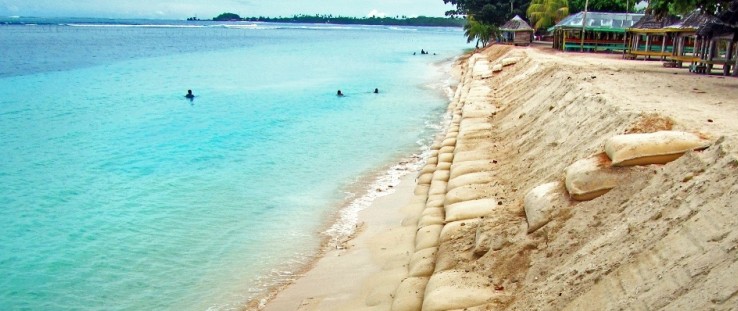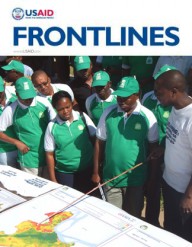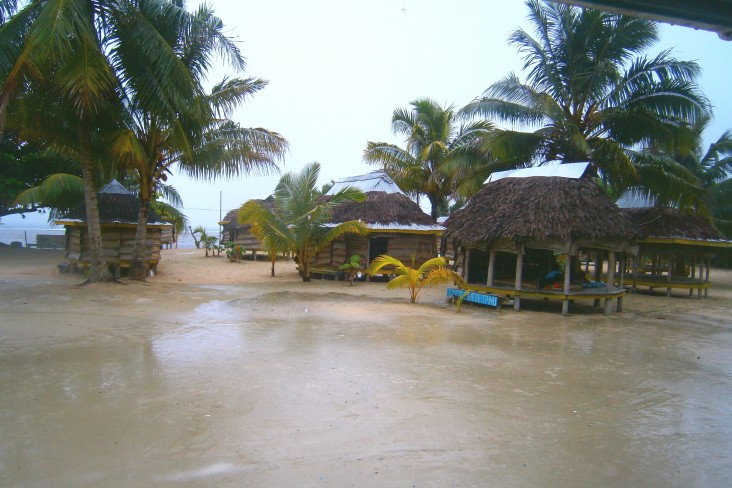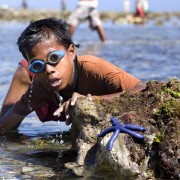 Resistant to punctures and ultraviolet rays, these sturdy, multiple-ply bags are filled with sand, discreetly working double time as they protect the coastline while preserving the shore’s natural look for many years to come.
C-CAP
Resistant to punctures and ultraviolet rays, these sturdy, multiple-ply bags are filled with sand, discreetly working double time as they protect the coastline while preserving the shore’s natural look for many years to come.
C-CAP
 Resistant to punctures and ultraviolet rays, these sturdy, multiple-ply bags are filled with sand, discreetly working double time as they protect the coastline while preserving the shore’s natural look for many years to come.
C-CAP
Resistant to punctures and ultraviolet rays, these sturdy, multiple-ply bags are filled with sand, discreetly working double time as they protect the coastline while preserving the shore’s natural look for many years to come.
C-CAP
For two decades, residents of Manase—a village located on the northeast coast of Samoa—have watched their coastline crumble into the sea.
Its white sandy beach attracts global travelers, and many of the village’s 150 residents depend on a locally owned resort—Tanu Fales—for their livelihood. But with increasing flooding, erosion, storm surges and other destructive natural forces, the people of Manase face an uncertain future.
“The sea level rose noticeably in the past 20 years,” said Taito Vaea Tanumafili, manager of Tanu Fales. Before, he says, the beach’s pristine profile extended 10 meters into the sea from the current shoreline. In 2004, Tropical Cyclone Heta transformed the landscape overnight. The severe storm carved a berm extending across the entire coastline. “The top layer of the first five meters of the beach were stripped away,” Tanumafili said.
Rising sea levels and extreme wave action slowly eroded the berm, creating a cliff with a three-meter vertical drop. High tide now reaches its base, eroding the beach each day. This has pushed the resort further inland and packed the resort’s bungalows closer together.
“Tourism is our family’s and community’s livelihood,” said Tanumafili. “We must protect our white, sandy beach.”
Throughout the Pacific Islands, USAID is preparing populations to survive and prosper while rising sea levels, droughts, floods and other devastating events force people to adapt their lives to a world affected by climate change.
Through the Coastal Community Adaptation Project (C‑CAP), implemented by Development Alternatives Inc., USAID works with more than 70 communities supporting local-level climate change interventions in nine Pacific Island countries, teaching people how to adapt to climate change and contribute to the region’s resilience.
C-CAP’s keystone activity develops small-scale infrastructure projects to help people cope with climate change. In Nukulka, Tonga, C-CAP renovated a community hall, upgrading the walls, adding protective grates on the windows and installing water and sanitation facilities. Besides hosting meetings and social events, the building can now provide secure shelter during extreme weather events. In Papua New Guinea, C-CAP installed 14 rainwater catchments in four communities and refurbished a central medical aid post with climate-proof roofing.
“These are not just any infrastructure projects. They provide critical, life-sustaining needs to people—water, shelter, flood protection,” says C-CAP Chief of Party Stephen Smith.
The project works with local leaders, village elders, women’s groups and other community players, collectively deciding what key infrastructures are most at risk, and most important to save.
In January 2015, the project hosted a meeting for the people of Manase, during which they agreed that sea level rise, extreme tidal movements and sea surges present the most significant risks. However, they wanted to avoid building a concrete seawall for protection, as it would further mar the natural beauty of Tanu Fales and affect the resort’s business. Villagers also mentioned that rainfall has decreased, affecting their water supplies and crops.
As with all other C-CAP communities, Manase villagers gathered to draw maps on poster board-sized paper so they could visually analyze the layout of their community’s assets. From this depiction, they decided what needed to be saved first. The Tanu Fales resort topped the list. Other assets included a main road that provides access to nearby villages and plantations. Bridges, a church, a water reservoir and drainage systems were also prioritized.
Simple Innovations
C-CAP then deployed its engineers, who introduced geotextile bags as a way to rebuild the coastline. Resistant to punctures and UV rays, these sturdy, multiple-ply bags are filled with sand, discreetly working double time as they protect the coastline from the ocean’s fury, while preserving the shore’s natural look for many years to come.
The geotextile bags support vegetative growth that stabilizes and integrates the barrier structure, unlike the damage traditional sandbags can cause. Residents then helped plant vegetation, which should grow over and eventually conceal the bags, becoming a permanent and natural barrier from the sea.
The Samoa Tourism Authority (STA) donated equipment that was used to build the barrier. “STA is exploring how to replicate the Tanu Fales wall in other coastal tourism locations,” says Amiaifolau Afamasaga Luatua, STA tourism climate change project manager. “We are assessing the most climate change-vulnerable areas and determining where we can apply this innovative technology.”
Looking Ahead
USAID’s support allows C-CAP to infuse the communities’ hand-drawn maps with country-level climate change trend projections, creating a digital planning tool on the free platform Google Maps. C-CAP then shares the maps with government partners, team members in the United States, and USAID/Pacific Islands to facilitate disaster management planning.
USAID also provides grants to civil society organizations through its $24 million grant-making facility, Pacific-American Climate Fund (PACAM), supporting projects that help communities adapt to climate change and address other priorities, such as livelihoods, health, food and water security, ecosystem conservation, and governance.
For example, USAID recently awarded a grant to the Namdrik Atoll Development Association in the Marshall Islands, helping to launch a project to expand pearl farming as a sustainable livelihood for the Namdrik community, a low-lying atoll of the country. The organization trained farmers in techniques, increasing their harvest from 3,000 to 20,000 pearl oysters and providing income for people whose traditional farming practices are affected by climate change.
“A one-size-fits-all approach will not effectively support communities spread across the earth’s largest ocean,” says USAID/Pacific Islands Regional Director Richard Edwards. “The people in these countries are our partners, providing the local knowledge necessary to develop effective solutions to preserve lives and livelihoods as their communities become increasingly impacted by a changing climate.”
Back in Samoa, Tanumafili witnessed the redevelopment of his beach, beaming as he saw a better future for himself and his family. “Before, there was nothing we could do but see our beach and land slowly become lost to the sea,” he said. “Today, our beach is safer, benefiting us greatly in the next 10 to 20 years.”
Kathryn Williams Smith, communications officer, and Cecilia Amosa, country mobilizer–Samoa, both with C-CAP, contributed to this article.















Comment
Make a general inquiry or suggest an improvement.